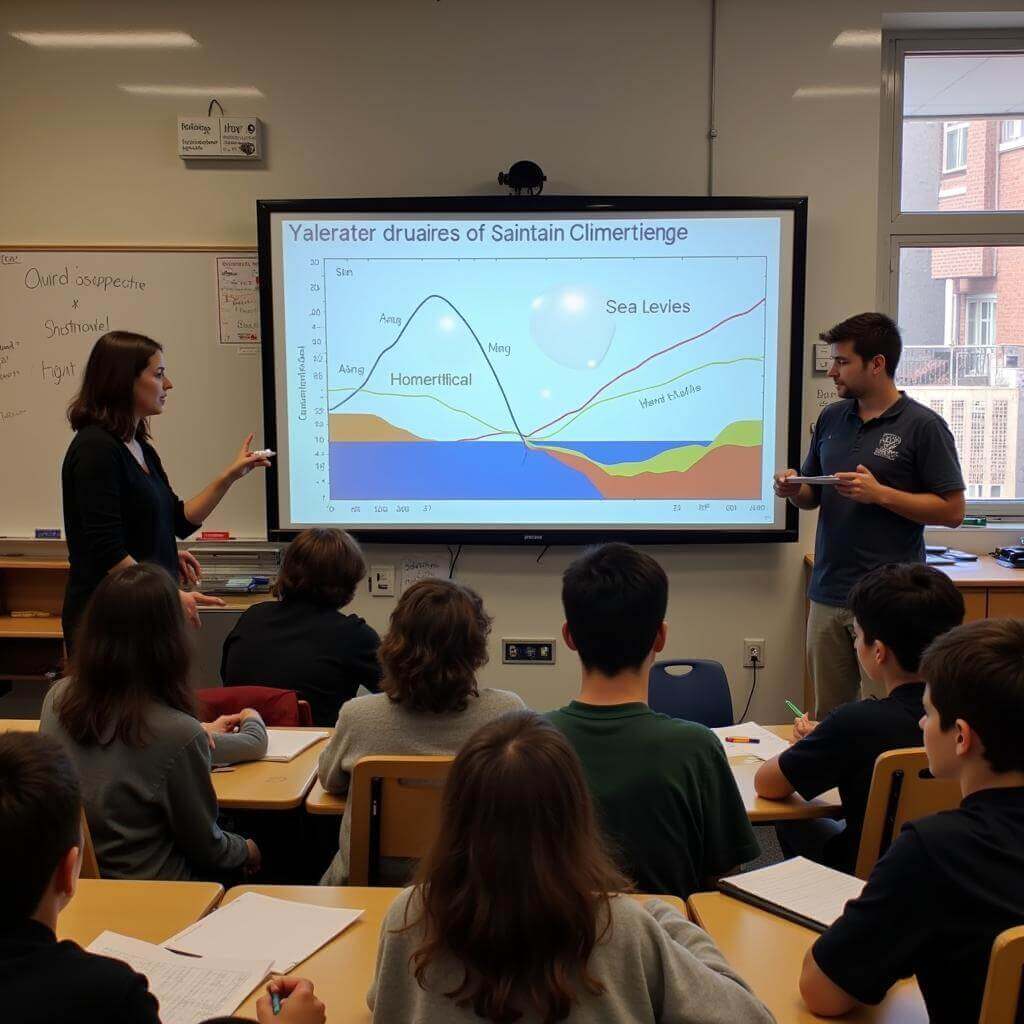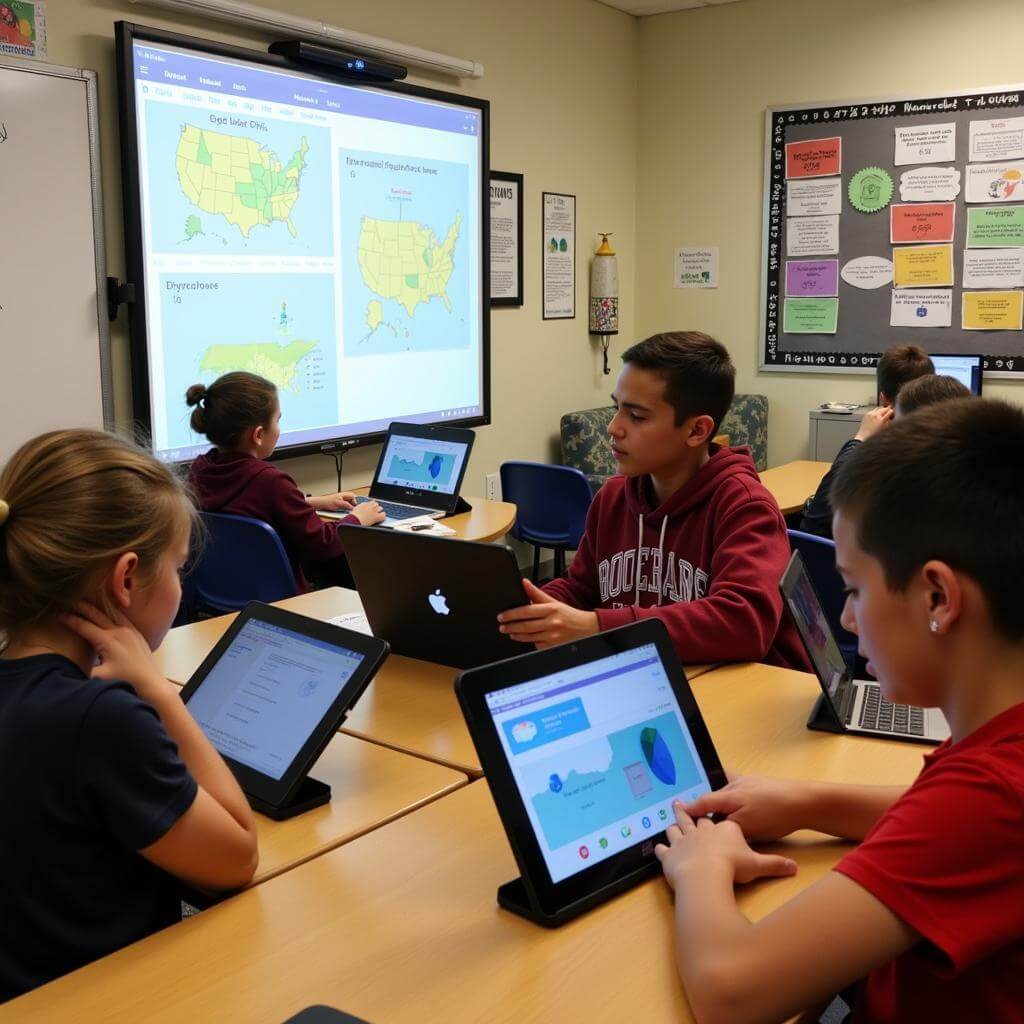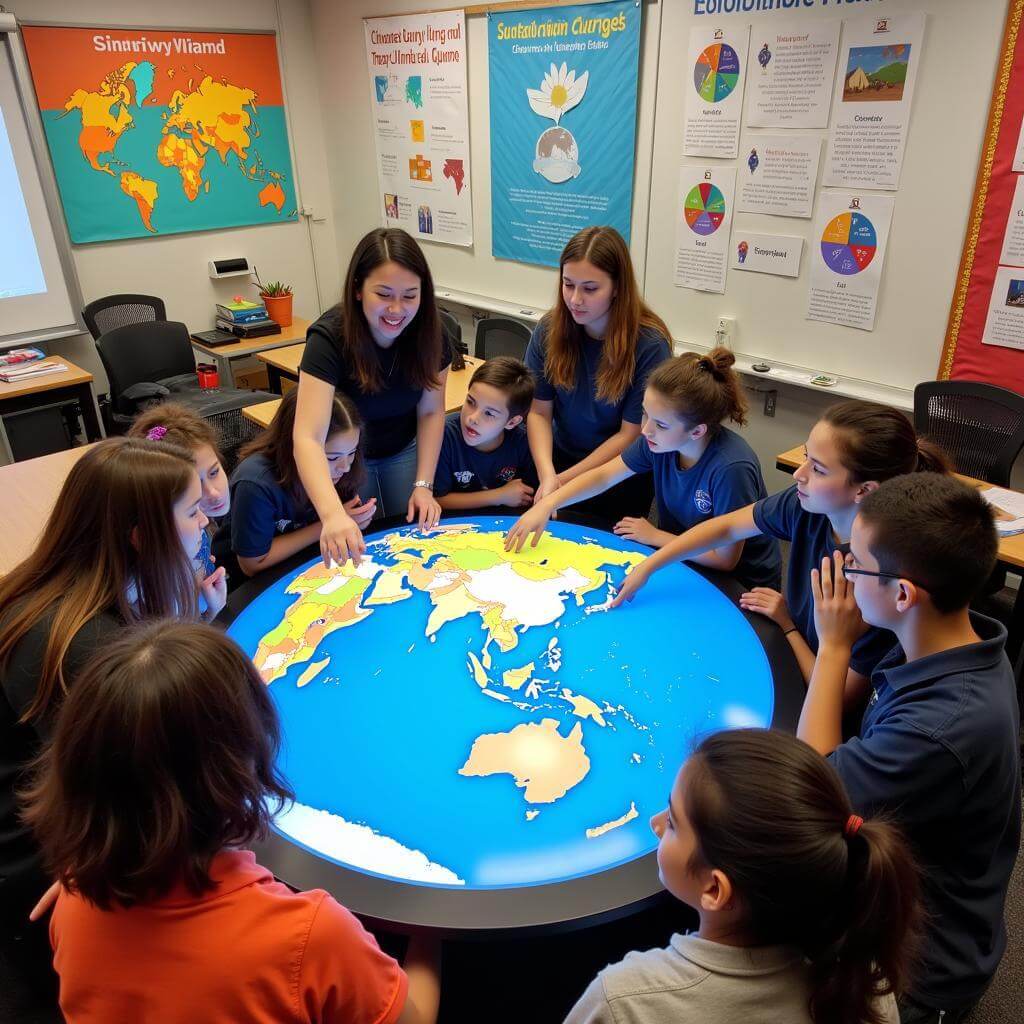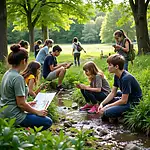Climate change education is becoming an increasingly important topic in school curriculums worldwide. As an experienced IELTS instructor, I’ve noticed this theme appearing more frequently in Reading passages. Let’s explore this subject through a practice IELTS Reading test, which will help you prepare for similar topics in your exam.
How international curriculums promote cultural inclusivity is another important aspect of modern education that often intersects with climate change education. Both topics reflect the global nature of contemporary challenges and the need for a more interconnected approach to learning.
IELTS Reading Practice Test
Passage 1 – Easy Text
Climate change education has become a crucial component of school curriculums across the globe. As the impacts of global warming become increasingly evident, educators are recognizing the need to equip students with the knowledge and skills to understand and address this pressing issue.
Many schools are now integrating climate change topics into various subjects, from science and geography to social studies and literature. This interdisciplinary approach ensures that students grasp the complex nature of climate change and its far-reaching effects on society, the economy, and the environment.
One key aspect of climate change education is teaching students about the greenhouse effect and its role in global warming. Students learn how human activities, particularly the burning of fossil fuels, release carbon dioxide and other greenhouse gases into the atmosphere, trapping heat and leading to rising global temperatures.
Additionally, curriculums often include lessons on the consequences of climate change, such as sea-level rise, extreme weather events, and biodiversity loss. By understanding these impacts, students can better appreciate the urgency of addressing climate change and the need for sustainable practices.
Many schools also focus on empowering students to take action. This may involve teaching about renewable energy sources, conservation techniques, and sustainable lifestyle choices. Some schools even encourage students to participate in climate-related projects or initiatives within their local communities.
 Climate change education integrated into school curriculum
Climate change education integrated into school curriculum
Questions 1-5
Do the following statements agree with the information given in the reading passage?
Write:
TRUE if the statement agrees with the information
FALSE if the statement contradicts the information
NOT GIVEN if there is no information on this
- Climate change education is limited to science classes.
- The greenhouse effect is a key topic in climate change education.
- Students learn about both the causes and effects of climate change.
- All schools require students to participate in local climate initiatives.
- Climate change education includes teaching about sustainable practices.
Questions 6-10
Complete the sentences below.
Choose NO MORE THAN TWO WORDS from the passage for each answer.
- Climate change education uses an ___ approach to cover various subjects.
- The burning of ___ is cited as a major contributor to greenhouse gas emissions.
- Rising ___ is mentioned as one consequence of climate change.
- Schools teach about ___ energy sources as part of climate change education.
- Some schools encourage students to engage in climate-related ___ in their communities.
Passage 2 – Medium Text
The integration of climate change education into school curriculums represents a paradigm shift in how we prepare future generations for global challenges. This shift is not merely about adding new content to existing subjects; it’s about fundamentally restructuring our approach to education to foster environmental literacy and create informed, engaged citizens capable of addressing complex ecological issues.
One of the primary challenges in implementing comprehensive climate change education is the need for teacher training. Many educators, particularly those who completed their training before climate change became a mainstream concern, may lack the specialized knowledge required to effectively teach this multifaceted topic. To address this, many school districts and educational institutions are developing professional development programs focused on climate science, sustainability, and interdisciplinary teaching methods.
Another crucial aspect of climate change education is its emphasis on critical thinking and problem-solving skills. Rather than simply presenting facts about global warming, effective curriculums encourage students to analyze data, evaluate different perspectives, and develop innovative solutions. This approach not only deepens understanding of climate issues but also cultivates valuable skills applicable across various disciplines and real-world scenarios.
The integration of technology plays a significant role in modern climate change education. Interactive simulations, data visualization tools, and online collaborations with scientists and students from around the world can bring climate science to life in ways that traditional textbooks cannot. These technological resources allow students to explore complex climate models, analyze real-time data, and understand the global nature of environmental challenges.
Furthermore, climate change education often extends beyond the classroom walls. Many schools are incorporating experiential learning opportunities, such as field trips to renewable energy facilities, participation in citizen science projects, or the creation of school gardens and composting programs. These hands-on experiences help students connect abstract concepts to tangible realities and foster a sense of environmental stewardship.
 Interactive climate change learning tools in classroom
Interactive climate change learning tools in classroom
Questions 11-15
Choose the correct letter, A, B, C, or D.
-
According to the passage, the integration of climate change education into curriculums is:
A) A simple addition of new content
B) A fundamental restructuring of education
C) Limited to science subjects
D) Only focused on environmental literacy -
One of the main challenges in implementing climate change education is:
A) Lack of student interest
B) Insufficient funding
C) Need for teacher training
D) Resistance from parents -
The passage suggests that effective climate change education should emphasize:
A) Memorization of climate facts
B) Critical thinking and problem-solving
C) Political activism
D) Outdoor activities only -
The role of technology in climate change education is described as:
A) Optional and rarely used
B) Limited to showing documentaries
C) Significant, offering interactive and collaborative tools
D) Mainly for administrative purposes -
Experiential learning in climate change education involves:
A) Only classroom-based activities
B) Exclusively online courses
C) Hands-on experiences outside the classroom
D) Theoretical discussions about the environment
Questions 16-20
Complete the summary below.
Choose NO MORE THAN TWO WORDS from the passage for each answer.
Climate change education aims to create environmentally literate and (16) citizens. It requires (17) for teachers to effectively deliver the content. The curriculum emphasizes (18) skills, using technology like (19) to enhance learning. Many schools also incorporate (20) ___ learning experiences to connect abstract concepts with real-world situations.
Passage 3 – Hard Text
The integration of climate change education into school curriculums is a complex and multifaceted endeavor that reflects the intricate interplay between scientific understanding, pedagogical approaches, and societal values. This educational paradigm shift is not merely a response to current environmental crises but a proactive strategy to cultivate a generation equipped with the knowledge, skills, and ethos necessary to navigate an increasingly uncertain climatic future.
At the core of this educational transformation is the concept of climate literacy, which encompasses not only a grasp of climate science fundamentals but also an understanding of the anthropogenic factors driving climate change and the myriad ways in which climatic shifts impact ecological, social, and economic systems. This holistic approach necessitates a curriculum that transcends traditional disciplinary boundaries, fostering what educators term transdisciplinary learning.
The implementation of such a curriculum, however, presents significant challenges. One primary obstacle is the politicization of climate science, which can lead to resistance from various stakeholders, including parents, school boards, and even some educators. This contentious atmosphere necessitates a delicate balancing act between presenting scientific consensus and acknowledging areas of ongoing research and debate. Educators must navigate this terrain carefully, employing evidence-based pedagogical strategies that encourage critical thinking and scientific inquiry while remaining sensitive to diverse perspectives.
Another challenge lies in the rapid evolution of climate science itself. The dynamic nature of this field requires educators to continuously update their knowledge and adapt their teaching materials. This necessitates the development of flexible curricular frameworks and robust professional development programs that keep teachers abreast of the latest scientific findings and emerging technological tools for climate education.
Furthermore, effective climate change education must grapple with the psychological dimensions of the subject. The existential nature of climate threats can induce anxiety and despair among students, potentially leading to eco-anxiety or a sense of helplessness. Pedagogical approaches must therefore strike a balance between conveying the urgency of the climate crisis and empowering students with actionable strategies for mitigation and adaptation. This often involves incorporating solution-oriented projects and community-based initiatives that allow students to engage directly in climate action.
The assessment of climate change education presents its own set of challenges. Traditional standardized testing methods may be ill-equipped to evaluate the complex, interdisciplinary understanding required for true climate literacy. Educators and policymakers are thus exploring alternative assessment methodologies, such as portfolio-based evaluations, project assessments, and real-world problem-solving scenarios that can more accurately gauge students’ ability to apply their knowledge in practical contexts.
Ultimately, the integration of climate change education into school curriculums represents a critical investment in our collective future. By fostering a generation of climate-literate citizens, we not only prepare students for the challenges they will face but also cultivate the innovative thinking and global perspective necessary to drive sustainable solutions on a planetary scale.
 Students exploring global climate change impacts
Students exploring global climate change impacts
Questions 21-26
Complete the sentences below.
Choose NO MORE THAN TWO WORDS from the passage for each answer.
- Climate change education is described as a ___ to prepare future generations for environmental challenges.
- The concept of climate literacy includes understanding the ___ causing climate change.
- The curriculum for climate change education goes beyond traditional subjects, promoting ___ learning.
- One major challenge in implementing climate change education is the ___ of climate science.
- Teachers need to use ___ strategies to encourage critical thinking about climate change.
- The rapidly changing nature of climate science requires the development of ___ for curricula.
Questions 27-33
Do the following statements agree with the claims of the writer in the reading passage?
Write:
YES if the statement agrees with the claims of the writer
NO if the statement contradicts the claims of the writer
NOT GIVEN if it is impossible to say what the writer thinks about this
- Climate change education is solely focused on teaching scientific facts.
- The politicization of climate science can create difficulties in teaching the subject.
- All stakeholders universally support the integration of climate change education.
- Educators must regularly update their knowledge due to advancements in climate science.
- Climate change education should avoid discussing the psychological impact on students.
- Traditional testing methods are adequate for assessing climate change education.
- Integrating climate change education is crucial for developing sustainable solutions.
Questions 34-40
Complete the summary below.
Choose NO MORE THAN TWO WORDS from the passage for each answer.
Climate change education in school curriculums is a complex process that aims to develop (34) in students. This approach faces challenges such as the (35) of climate science and the need for teachers to continually update their knowledge. The curriculum must balance scientific information with (36) to avoid causing anxiety in students. Assessment of this education requires (37) that go beyond traditional testing methods. Despite these challenges, climate change education is seen as an (38) in our future, aiming to create a generation of (39) citizens capable of developing (40) ___ on a global scale.
Answer Key
Passage 1
- FALSE
- TRUE
- TRUE
- NOT GIVEN
- TRUE
- interdisciplinary
- fossil fuels
- global temperatures
- renewable
- projects
Passage 2
- B
- C
- B
- C
- C
- engaged
- training
- critical thinking
- interactive simulations
- experiential
Passage 3
- proactive strategy
- anthropogenic factors
- transdisciplinary
- politicization
- evidence-based pedagogical
- flexible frameworks
- NO
- YES
- NOT GIVEN
- YES
- NO
- NO
- YES
- climate literacy
- politicization
- actionable strategies
- alternative assessment methodologies
- investment
- climate-literate
- sustainable solutions
By practicing with this IELTS Reading test focused on climate change education in school curriculums, you’ve not only enhanced your reading skills but also gained valuable insights into an increasingly important global issue. Remember to apply critical thinking and time management strategies as you tackle similar passages in your actual IELTS exam. Good luck with your preparation!


